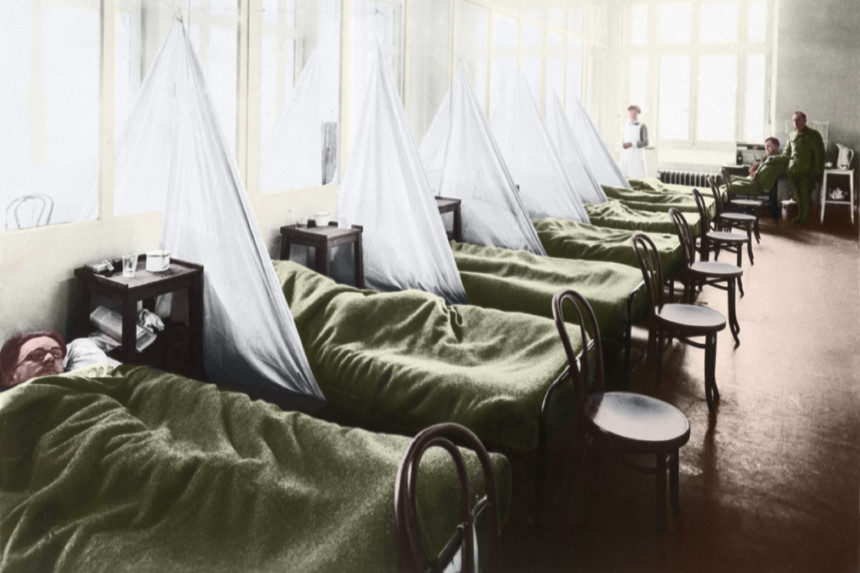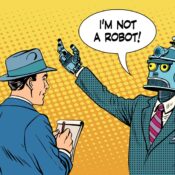For two years it raged across the world, infecting 500 million people — a third of all the people on earth — and killing 50 million. And then, the Spanish flu just seemed to fade away. The rate of infections and deaths dropped sharply through March and April of 1919.
So what ended it?
It wasn’t a vaccine, of course. Even if they could have developed one in 1918, scientists didn’t even know if the pandemic was caused by bacteria or a virus, and wouldn’t know until 1930.
Public health officials had little choice but to give the virus fewer chances to spread. Social distancing, mask-wearing, frequent hand washing, isolating patients, and closing public venues all worked to hem in the virus.
Another factor in the pandemic’s end was the nature of viruses. Some viruses continually mutate in a process called “antigenic drift or shift,” which could enable them to develop into a deadly strain that is immune to human antibodies.
But they can also mutate into a less deadly version. The Spanish flu didn’t die off but “drifted” into an altered form.
In the winters of 1919-1920 and 1920-1921, the Spanish flu made a comeback, but it had now morphed into a less virulent virus, whose symptoms were almost identical to a seasonal flu.
In fact, the influenza strain that causes the Spanish flu has remained with us, becoming the agent responsible for our routine winter illnesses. It is benign, compared to its deadly 1918 form.
We are, of course, still susceptible to flu viruses. In the last 10 years, the annual death rate from flu has ranged from 12,000 to 61,000.
Occasionally, the flu virus combines genetic material with a swine flu or bird flu to create a deadly new form (this is the more abrupt antigenic “shift”). In 1957, an H2N2 virus combined with an avian flu virus to produce the Asian flu, killing 1-4 million people worldwide. Because the virus was new, few people had immunity. In 1968, another combination with avian flu resulted in the H3N2 Hong Kong flu. The H3N2 virus continues to circulate worldwide as a seasonal influenza A virus. In 2009, a combination with a porcine virus produced the swine flu epidemic of that year.
Each had some element of the 1918 Spanish flu.
The ideal solution for the flu or other deadly viruses would be to rid the world of them completely. But, as Dr. Kirsty Short from Australia’s University of Queensland told ABC News, getting a virus out of the human population is incredibly difficult: “We’ve only ever done it with one human pathogen, and that’s smallpox.” It took a global immunization campaign, with a vaccine that was 100 percent effective against smallpox and any mutation of the virus.
The idea of achieving herd immunity by simply stepping back and allowing a virus free rein to infect everyone wouldn’t work, either. Dr. Howard Markel of the University of Michigan told WebMD, “you would never get levels of 60 percent to 90 percent, which is what people are estimating you would need.”
Dr. Jeffrey Shaman, an epidemiologist at Columbia University, estimates that 105 million Americans — about a third — have contracted the coronavirus. Our population hasn’t yet reached the 70 percent needed for herd immunity to start reducing the number of infections. But this assumes that, once infected or immunized, people with remain immune to further infection.
If all goes well and we are able to administer President Biden’s goal of 1.5 million shots per day, the United States could achieve herd immunity by November of this year, according to Reuters’ calculations. But much of that depends on the number of people who are willing to be vaccinated. As Director of National Institute of Allergy and Infectious Diseases Anthony S. Fauci has said, “if only 40 to 50 percent of people in society get vaccinated, it’s going to take quite a while…to get to that blanket of herd immunity.”
Or we could get lucky and the virus could mutate to a less deadly strain, like the Spanish flu did. Fortunately, advances in science over the last hundred years mean that we no longer have to rely on luck alone.
Featured image: Everett Collection / Shutterstock
Become a Saturday Evening Post member and enjoy unlimited access. Subscribe now




Comments
Bob McGowen I think you missed the point. How did we survive this long? The Spanish Flu was every bit as powerful as Covid-19. There was no vaccine. And yet it faded, just like Covid-19 is currently doing and will continue to do. Less harmful, more contagious as variants mutate. We think we are in control, but we aren’t. This is just a grain of sand in human history. How egocentric is it to claim that the world will never recover? Our biggest problem right now is we know just enough about viruses to be dangerous, but not enough to solve the difficult problems.
“For two years it raged across the world, infecting 500 million people, and killing 50 million — a third of all the people on earth.”
QUESTION: If 50 million people died from the spanish flu representing “a third of all the people on earth” (meaning there were only 150 million people on earth), then how could 500 million have become infected??? The math does not equate.
A really good article Jeff. For all our technology today (often swords that cut both ways) it has all it can do to try to keep up with new versions of plagues from centuries ago. So much of how/when it’s under control depends on the American public, which enough of a percentage never learn their lessons regarding mask wearing and not continually gathering at ‘holiday events’.
It’s not rocket science at all, but apparently too much for too many people with vanilla pudding up there to ‘get’. Last Easter, Mother’s Day, Memorial Day, Father’s Day, 4th of July, Labor Day, Halloween, Thanksgiving, Christmas, New Year’s and now last Sunday’s Superbowl. 11 times, nearly one a month, and still blatant disregard of the warnings ahead of time from Dr. Fauci and many other experts. Just watch the numbers go WAY up in mid-late February.
I’m willing to get the vaccine but which one? It keeps changing by the day. Since we weren’t around in 1918-’21 we can’t say how things were afterwards vs. before. I just can’t see a return of 2019 and earlier ever again. Everything was already getting more restricted in the U.S. for a long time as it was, otherwise. The virus and last month’s deadly insurrection are only going to make the tightness tighter, permanently.
I never knew a mutated form of the 1918 resurfaced the year I was born, killing 1-4 million people worldwide. That’s very serious, and apparently not that well known. It seems to have under control in the U.S. per the link. Same with 1968, then again in 2009, at least here. If it had remained on an 11 year cycle, we would have had them in 1979, 1990 and 2001. We still have to be on guard for that one too, much less the constantly mutating corona virus. We also need to remember we’re never far away from the Dark Ages when the power goes out and stays out for very long. Electricity and medical advances (due in large part TO electricity) are the biggest separators of us from Medieval times, lest we shan’t forget.